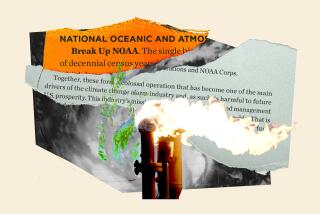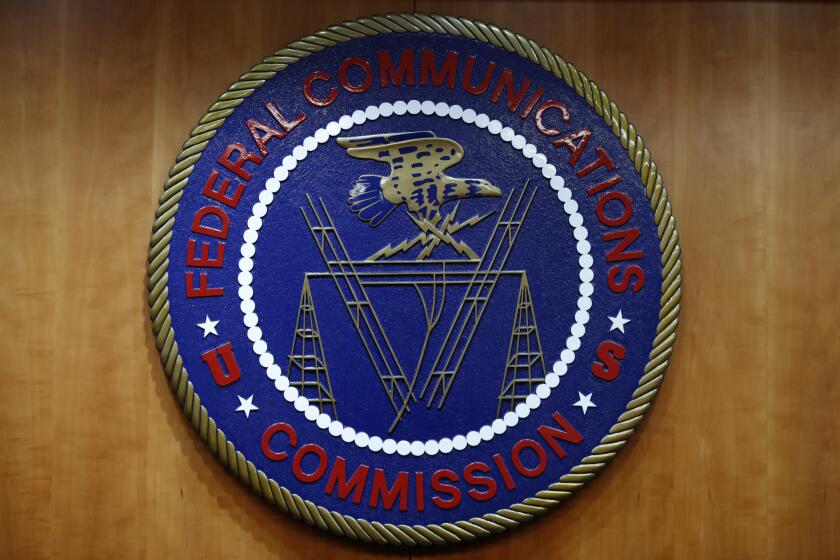U.S. Proposing Global Effort to Preserve Ozone
WASHINGTON — Faced with growing scientific alarm about potential damage to the Earth’s protective ozone layer, the Reagan Administration is proposing global limits on chemicals believed to deplete the ozone and trigger cases of skin cancer.
At a meeting of up to 50 nations in Geneva beginning Monday, the Administration will propose a “near-term freeze” on the emission of such chemicals and their phase-out over the longer term. The proposal represents a shift for President Reagan, who early in his Administration called only for more research.
The U.S. proposal, announced earlier this month, followed months of warnings by Environmental Protection Agency Administrator Lee M. Thomas that regulations may be necessary to curb use of man-made gases that may reduce the stratospheric ozone, a shield that absorbs much of the sun’s harmful radiation. Industries that produce and use the suspect chemicals announced support in September for global limitations.
“There is general consensus now developing that we’re entering a danger zone,” said John Rouse, director of the Office of Environment and Health at the State Department.
The Geneva meeting is the first major attempt to devise an international agreement to limit emissions of ozone-threatening chemicals, mostly in the form of compounds called chlorofluorocarbons, or CFCs.
These chemicals are commonly used in aerosols, air conditioning, refrigerators and solvents, although the United States, Canada and some Scandinavian countries have banned their use in aerosols. In those countries, they are emitted into the atmosphere primarily from manufacturing plants, leaking automobile air conditioning systems and solvent processes.
If CFC production trends continue at present rates, scientists said, the compounds will reduce the ozone layer by 5% to 10% in the next 50 years.
In that case, the EPA, in a draft report still awaiting scientific review, recently projected an additional 40 million skin cancer cases worldwide--and 800,000 deaths--in the next 88 years. And those are not the only dangers.
“If depletion occurs,” the report warns, “additional cataract cases could be expected, along with increased suppression of the immune system. The effect of this immune suppression on infectious diseases like herpes . . . would be to reduce the body’s capacity to prevent spread or outbreaks.”
Participants in preparatory meetings to this week’s talks in Geneva, organized under the United Nations Environment Program, said that support for global limitations is growing, although a final agreement is not expected for several months.
“We’re going into the conference with momentum . . . “ said Rafe Pomerance, senior associate of the World Resources Institute, a Washington-based think tank for global natural resource issues. “The question is whether the momentum continues in a constructive manner.”
In 1974, scientists first reported that CFCs were rising into the stratosphere six to 30 miles above the Earth, breaking apart and depleting the ozone. Although ozone created by man-made chemicals on the ground causes health problems and acts as a catalyst for acid rain, stratospheric ozone is an environmental boon because it protects the Earth from ultraviolet radiation.
For several years after the United States banned CFCs in aerosols in the mid-1970s, worldwide production dropped below its 1974 peak. But in the last three years, production has climbed back to 1974 levels and may soon exceed them. In the United States, for example, use of the compounds in air conditioning and plastics has grown.
Manufacturers and users of CFCs announced in September that they would accept global limitations. The Alliance for Responsible CFC Policy, formed in 1980 to lobby on behalf of the chemical users and manufacturers, called for a negotiated ceiling on global production capacity and the development domestically of a voluntary program to conserve, recapture or recycle the compound.
“The science appeared to justify that position and, in order to continue to have these things available, we had to show we were willing to act responsibly,” said Kevin Fay, director of the group.
But Fay’s group opposes a long-term phase-out of the chemicals. Industry estimates that 5,000 U.S. businesses use CFCs to produce more than $28 billion in goods and services a year.
Concern about ozone loss intensified recently as a result of reported holes in the ozone layer over Antarctica and the Northern Hemisphere. Scientists, however, are still not certain whether the holes are caused by chemicals or by natural forces.
The gases that deplete ozone in the stratosphere are also believed to contribute to an increase in what is known as the “greenhouse effect” when they accumulate in the lower atmosphere and prevent solar heat on Earth from escaping back into space.
Scientists who testified before a Senate subcommittee earlier this year cited evidence that a warming trend may already be under way and predicted dramatic climatic changes that could devastate crops and cause sea levels to rise in the next century.
Since the mid-1970s, Du Pont, the world’s largest maker of CFCs, has found alternatives for many, but not all, uses of the compound. But company officials said that neither demand nor regulation exists to make production of the alternatives viable.
“If the necessary incentives were provided, we believe alternatives could be introduced in volume in a time frame of roughly five years,” the company said in a Sept. 26 letter to users of Freon, the firm’s trademark for its chlorofluorocarbons.
The company now favors a worldwide limit on emissions. “The science continues to indicate no imminent hazard to health or the environment from CFCs at current emission levels,” the company said in a position paper. “However, the use of CFCs worldwide is growing, and the science is not yet sufficiently developed to define with certainty a safe CFC emission growth rate.”
More to Read
Sign up for Essential California
The most important California stories and recommendations in your inbox every morning.
You may occasionally receive promotional content from the Los Angeles Times.











